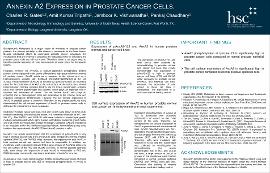| dc.contributor.advisor | Chaudhary, Pankaj | |
| dc.contributor.author | Gates, Charles R. | |
| dc.contributor.author | Tripathi, Amit Kumar | |
| dc.contributor.author | Vishwanatha, Jamboor K. | |
| dc.contributor.other | Langston University | |
| dc.contributor.other | University of North Texas. Health Science Center at Fort Worth | |
| dc.date.accessioned | 2021-09-28T01:09:22Z | |
| dc.date.available | 2021-09-28T01:09:22Z | |
| dc.date.issued | 2021-10-09 | |
| dc.identifier | oksd_OK-LSAMP_2021_gates | |
| dc.identifier.citation | Gates, C. R., Tripathi, A. K., Vishwanatha, J. K., & Chaudhary, P. (2021, October 9). Annexin A2 expression in prostate cancer cells. Poster session presented at the Oklahoma Louis Stokes Alliance for Minority Participation's 27th Annual Research Symposium, Stillwater, OK. | |
| dc.identifier.uri | https://hdl.handle.net/11244/330976 | |
| dc.description.abstract | Background: Metastasis is a major cause of morbidity in prostate cancer patients, the primary mortality in this disease is metastasis to the bone tissue. Despite substantial efforts to understand prostate cancer metastasis, the mechanisms that are involved in preparing the metastatic niche for colonizing the prostate cancer cells are still not known. Therefore, there is an urgent need to identify essential regulators of bone metastasis in prostate cancer for therapeutic targets. | |
| dc.description.abstract | Purpose: Annexin A2 (AnxA2), a calcium-dependent phospholipid binding protein, is overexpressed in the poorly differentiated high-grade adenocarcinomas of prostate cancer. AnxA2 exists as a monomer in the cytosol and as a heterotetrameric complex with S100A10 [(AnxA2)2-(S100A10)2] at the cell surface. Phosphorylation of AnxA2 at tyrosine 23 (pAnxA2-Y23) is an important event for the localization of AnxA2 to the cell surface. At the cell surface, AnxA2 heterotetramer complex provides binding site for tissue plasminogen activator (tPA) and converts plasminogen into plasmin, which plays an important role in invasion and metastasis of cancer. The cell surface AnxA2 also plays an important role in hematopoietic stem cell localization to the marrow niche and regulates osteogenic differentiation. However, the cell surface expression of AnxA2 in prostate cancer is unknown. Therefore, in the present study, we have demonstrated the cell surface expression of AnxA2 in prostate cancer cells to delineate the mechanism of bone metastasis. | |
| dc.description.abstract | Methods: Prostate cancer cell lines, PC3 and DU145 were grown in RPMI-1640 medium containing 10% fetal bovine serum, in a humidified incubator at 37ºC with 5% CO2. The RWPE1, and PWR-1E cells were cultured in keratinocyte growth medium supplemented with 5 ng/ml human recombinant epidermal growth factor and 0.05 mg/ml bovine pituitary extract (Invitrogen, Carlsbad, CA) and maintained in an incubator under the conditions described above. Immunoblotting was used to detect the expression of pAnxA2-Y23 and AnxA2 proteins in cells. | |
| dc.description.abstract | Results: Our results demonstrated that the expression of pAnxA2-Y23 is very high in prostate cancer cells (PC3 and DU145 cells) compared to normal prostate epithelial (PWR1E, and RWPE1 cells). However, the expression of total AnxA2 in both prostate normal and cancer cell lines is comparable. In addition, our membrane wash experiment showed that a large amount of AnxA2 is present at the cell surface of the PC3 and DU145 cell lines. In normal prostate epithelial cells, even though the expression of total AnxA2 is comparable to PC3 and DU145 prostate cancer cells, membrane localization of AnxA2 is very low. | |
| dc.description.abstract | Conclusion: Our results clearly suggest that the cell surface expression of AnxA2 is high in prostate cancer cells due to increased phosphorylation of AnxA2 at tyrosine 23. | |
| dc.description.sponsorship | Oklahoma Louis Stokes Alliance for Minority Participation Program | |
| dc.format | application/pdf | |
| dc.language | en_US | |
| dc.publisher | Oklahoma State University | |
| dc.rights | In the Oklahoma State University Library's institutional repository this paper is made available through the open access principles and the terms of agreement/consent between the author(s) and the publisher. The permission policy on the use, reproduction or distribution of the article falls under fair use for educational, scholarship, and research purposes. Contact Digital Resources and Discovery Services at lib-dls@okstate.edu or 405-744-9161 for further information. | |
| dc.title | Annexin A2 expression in prostate cancer cells | |
| osu.filename | oksd_OK-LSAMP_2021_gates.pdf | |
| dc.description.department | Microbiology, Immunology and Genetics | |
| dc.description.department | Biology | |
| dc.type.genre | Poster | |
| dc.type.material | Text | |
| dc.subject.keywords | metastasis | |
| dc.subject.keywords | annexin a2 expression | |
| dc.subject.keywords | prostate cancer | |
